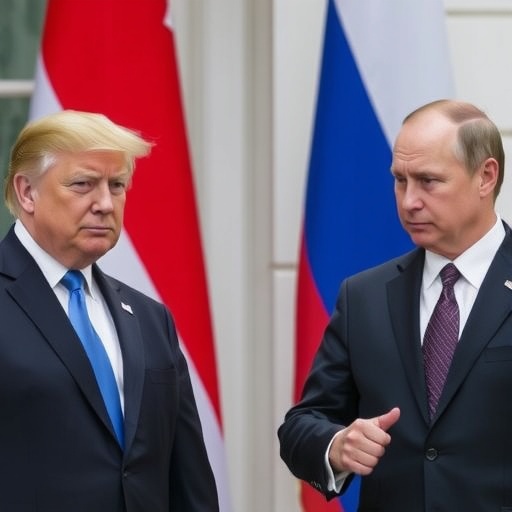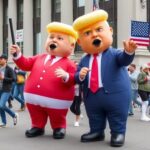No Immediate Trump-Putin Meeting: White House Dashes Hopes Amid Surging Geopolitical Tensions
In a move that underscores the fragile state of U.S.-Russia relations, the White House has firmly stated there are no immediate plans for a summit between President Donald Trump and Russian President Vladimir Putin. This announcement, delivered amid escalating geopolitical tensions over issues like Ukraine and election interference, quells speculation that had been building for weeks about a potential face-to-face dialogue to ease global strains.
- White House Clarifies Stance on High-Stakes Summit Speculation
- Echoes of Past Trump-Putin Encounters Shape Current Delays
- Geopolitical Flashpoints Driving the Trump-Putin Diplomatic Freeze
- Expert Voices Weigh In on U.S.-Russia Relations Stagnation
- Future Pathways for Trump-Putin Diplomacy Amid Uncertainty
The revelation comes at a critical juncture, as diplomats worldwide watch closely for any sign of thaw in the icy bilateral ties. Sources within the administration indicate that while Trump has expressed a desire for improved relations with Moscow, pressing domestic and international priorities are taking precedence. “Diplomacy with Russia remains a key focus, but timing is everything,” a senior White House official told reporters on condition of anonymity, highlighting the delicate balance Trump must strike in his foreign policy agenda.
This development is particularly poignant given Trump’s history of praising Putin as a strong leader, a stance that has drawn both admiration and criticism from allies and adversaries alike. As the world grapples with the implications, questions swirl about what this delay means for future Trump-Putin diplomacy and the broader landscape of international security.
White House Clarifies Stance on High-Stakes Summit Speculation
The White House’s communication team wasted no time in addressing the rumors that had circulated through diplomatic channels and media outlets. Press Secretary Sarah Sanders, during a briefing on Tuesday, explicitly ruled out any near-term meeting between Trump and Putin. “At this moment, there are no plans for an immediate summit,” Sanders stated, emphasizing that the president’s schedule is packed with urgent matters including trade negotiations with China and domestic infrastructure pushes.
This clarification follows a series of ambiguous signals from the Trump administration. Just last month, Trump had hinted at the possibility of a meeting during a rally in Ohio, saying, “I’d love to sit down with Putin and sort out these problems—it’s better to talk than fight.” Such comments fueled optimism among those hoping for a diplomatic breakthrough, but insiders reveal that logistical hurdles and policy divergences have derailed those hopes for now.
Geopolitical analysts point to the Kremlin’s recent actions as a major factor. Russia’s continued support for separatists in eastern Ukraine, coupled with allegations of cyber meddling in Western elections, has hardened stances in Washington. According to a recent report by the Atlantic Council, U.S.-Russia tensions have reached levels not seen since the Cold War, with diplomatic expulsions and sanctions forming a web of retaliatory measures. Sanders’ announcement, therefore, serves not just as a scheduling update but as a signal of resolve amid these frictions.
Furthermore, the White House’s position aligns with broader NATO concerns. European allies, wary of any unilateral Trump-Putin engagement, have urged caution. A spokesperson for the European Union noted, “Any dialogue must be multilateral to ensure stability,” reflecting the international pressure influencing the decision.
Echoes of Past Trump-Putin Encounters Shape Current Delays
To understand the significance of this non-meeting, one must look back at the Trump-Putin interactions that have defined their tenures. Their first in-person encounter occurred at the 2017 G20 summit in Hamburg, Germany, where the two leaders held a lengthy private discussion that raised eyebrows for its secrecy. Trump later described it as “tremendous,” claiming they discussed ways to combat terrorism and improve relations.
Subsequent meetings, including at the 2018 Helsinki summit, were equally charged. In Helsinki, Trump’s comments appeared to side with Putin’s denial of election interference over U.S. intelligence assessments, sparking a firestorm of controversy. “I accept [Putin’s] word on that,” Trump said, a statement that drew sharp rebukes from Congress and the media. These moments highlighted the unpredictable nature of Trump-Putin diplomacy, where personal rapport often overshadowed policy substance.
Statistics from the State Department underscore the rocky path: Since 2017, over 200 Russian diplomats have been expelled from the U.S. in response to various incidents, while Russia has mirrored these actions. Trade volumes between the two nations have plummeted by 40% since sanctions were imposed in 2014, per U.S. Commerce Department data. Yet, Trump has repeatedly advocated for lifting some sanctions to foster economic ties, a position that clashes with hawkish elements in his administration.
Experts like Fiona Hill, former National Security Council director for Europe and Russia, have analyzed these past dynamics. In a recent interview with CNN, Hill remarked, “Trump’s affinity for Putin is genuine, but institutional barriers in Washington make quick diplomacy elusive.” Her insights reveal how bureaucratic inertia and congressional oversight continue to temper the president’s impulses, contributing to the current impasse.
Another layer involves the Mueller investigation’s shadow. Although Special Counsel Robert Mueller’s report cleared the Trump campaign of conspiracy with Russia, it detailed extensive contacts and left lingering suspicions. This history weighs heavily on any prospective Trump-Putin meeting, ensuring that diplomacy proceeds with extreme caution.
Geopolitical Flashpoints Driving the Trump-Putin Diplomatic Freeze
At the heart of the no-meeting announcement lie simmering geopolitical tensions that demand immediate attention elsewhere. The crisis in Ukraine remains a flashpoint, with Russian-backed forces clashing sporadically along the contact line. The Minsk agreements, intended to broker peace, have stalled, and U.S. military aid to Kyiv has surged to $250 million annually under Trump, signaling unwavering support for Ukraine’s sovereignty.
Putin’s government, meanwhile, has accused the West of provoking escalation by expanding NATO’s eastern flank. In a speech last week, Putin warned, “Attempts to corner Russia will meet a firm response,” rhetoric that has alarmed global markets and prompted a 2% dip in oil prices due to fears of supply disruptions.
Beyond Ukraine, Syria complicates matters. Russia’s intervention in 2015 bolstered the Assad regime, directly countering U.S. efforts to combat ISIS and support moderate rebels. Recent U.S. airstrikes on Iranian-linked targets in Syria have drawn Russian ire, with Moscow condemning them as “aggression.” A joint statement from the Russian Foreign Ministry read, “Such actions undermine counter-terrorism cooperation,” highlighting the divergent visions for the region’s future.
Cybersecurity issues further strain ties. The U.S. Cybersecurity and Infrastructure Security Agency (CISA) reported in its latest bulletin that Russian state actors attempted over 1,000 intrusions into critical infrastructure last year alone. These incidents, linked to groups like Fancy Bear, echo the 2016 election hacks and fuel demands for accountability before any Trump-Putin summit can occur.
Economically, the picture is grim. Sanctions have isolated Russia’s energy sector, with exports to Europe dropping 15% in 2019, according to the International Energy Agency. Trump, aiming to boost U.S. LNG exports, sees Russia as a competitor, adding another layer to the diplomatic standoff. As one energy analyst from Bloomberg noted, “Energy rivalry is the unspoken barrier to better relations—neither side wants to yield ground.”
Human rights concerns also play a role. The detention of opposition figures like Alexei Navalny and crackdowns on protests have drawn U.S. condemnation. Secretary of State Mike Pompeo recently tweeted, “America stands with the Russian people seeking freedom,” a message that underscores the ideological chasm separating Trump and Putin.
Expert Voices Weigh In on U.S.-Russia Relations Stagnation
As news of the delayed meeting spreads, a chorus of experts is dissecting its ramifications for Trump-Putin diplomacy. Angela Stent, director of the Center for Eurasian, Russian, and East European Studies at Georgetown University, argues that the pause could be strategic. “Trump wants leverage; rushing into a meeting without concessions from Moscow would weaken his position,” Stent said in an op-ed for The Washington Post.
Conversely, Matthew Rojansky from the Kennan Institute warns of missed opportunities. “In an era of arms control erosion—with the INF Treaty dead and New START expiring soon—direct talks are vital,” he told NPR. Rojansky points to data showing a 30% increase in global nuclear warheads since 2010, much of it attributable to U.S.-Russia posturing.
From Moscow’s perspective, Russian analyst Fyodor Lukyanov offers a sobering view. In a Kommersant article, he wrote, “Putin views Trump’s unpredictability as both a threat and an opening, but current tensions demand patience over haste.” This bilateral caution reflects a broader trend: Global diplomacy indices from the Council on Foreign Relations show U.S.-Russia cooperation scores at a historic low of 22 out of 100.
Domestic U.S. politics add complexity. With midterm elections looming, Trump’s Republican allies in Congress, led by figures like Senator Lindsey Graham, have pushed for tougher Russia policies. A recent poll by Pew Research found 68% of Americans view Russia unfavorably, pressuring the administration to prioritize security over summits.
International observers, including UN Secretary-General António Guterres, have called for renewed dialogue. “Multilateral forums like the UN can bridge gaps where bilateral talks falter,” Guterres stated during a General Assembly session, indirectly urging both Trump and Putin to reconsider their timelines.
Future Pathways for Trump-Putin Diplomacy Amid Uncertainty
Looking ahead, the absence of an immediate Trump-Putin meeting opens doors for alternative diplomatic channels. The U.S. is exploring backchannel communications through special envoy Steve Witkoff, who has met with Russian counterparts on arms control. Upcoming G20 and UN summits in 2020 could provide informal venues, though officials caution against expecting breakthroughs.
Policy implications are profound. Without direct engagement, U.S. sanctions may intensify, potentially targeting Russian oligarchs and banks. The Treasury Department’s recent designation of 25 entities under the CAATSA law illustrates this trajectory, with compliance costs estimated at $10 billion for global firms.
For Trump, this delay tests his deal-making prowess. Advisors suggest he might leverage it to extract concessions, such as intelligence sharing on North Korea or Afghanistan. Putin, facing domestic economic pressures with GDP growth at a mere 1.6%, may seek an olive branch to stabilize his position.
Global stability hangs in the balance. Analysts predict that prolonged stagnation could embolden adversaries like China, which has deepened ties with Russia through a $400 billion energy deal. As one Foreign Policy expert opined, “The Trump-Putin void risks a multipolar world more volatile than the bipolar Cold War.”
Ultimately, while no immediate meeting is on the horizon, the fluid nature of international affairs leaves room for change. Stakeholders on both sides emphasize that sustained diplomacy—through envoys, treaties, and confidence-building measures—remains essential to averting escalation. As tensions simmer, the world watches for the next move in this high-stakes geopolitical chess game.









